Research Article - Der Pharma Chemica ( 2023) Volume 15, Issue 6
In-silico Ligands Target Prediction of Potential Inhibitors against Dementia using Chemo Informatics Approach
Wamankar Suchita1*, Gupta Anshita2 and Kaur Chanchal Deep12Department of Pharmaceutical Sciences, Shri Rawatpura Sarkar Institute of Pharmacy, Chhattisgarh, India
Wamankar Suchita, Department of Pharmaceutical Sciences, Rungta Institute of Pharmaceutical Sciences, Chhattisgarh, Raipur, India, Email: suchitawamankar@gmail.com
Received: 28-Oct-2023, Manuscript No. DPC-23-118630; Editor assigned: 31-Oct-2023, Pre QC No. DPC-23-118630 (PQ); Reviewed: 14-Nov-2023, QC No. DPC-23-118630; Revised: 24-Nov-2023, Manuscript No. DPC-23-118630 (R); Published: 22-Dec-2023, DOI: 10.4172/0975-413X.15.6.154-165
Abstract
Background: One of the most prevalent neurodegenerative diseases, dementia is characterized by gradual memory loss and cognitive impairment. It has a variety of neurological signs that affect memory, judgement and social skills. The variety of ligands that may be investigated using experimental assays has fallen with the help of efficient in silico drug design techniques.
Methods: Through a review of the literature, seven phytochemicals that are effective against dementia were chosen for the current investigation. Using chemo-informatics tools like SWISS and the Molinspiration online server, these ligands were docked with putative Choline Esterase (ChE), N-Methyl-D-Aspartate (NMDA) and calcium channel receptors. Using in-silico study, the binding energies of the target-ligand complex and the ADME (absorption, distribution, metabolis and excretion) profile of phytochemicals were examined.
Results: A result showed that seven active phytochemicals had a higher binding energy values for Choline Esterase (ChE) receptor. And Resveratrol and Berberine also exhibited good ADME profiles that easily penetrate BBB and having potential inhibitory properties against Choline Esterase (ChE) receptor using chemo-informatics approaches.
Conclusions: These outcomes probably provide insight on the prospect of using resveratrol and berberine as an instance for developing new drugs for managing dementia.
Keywords
Phytochemicals; Dementia; In-Silico; Resveratrol; Berberine
Introduction
The term "dementia" refers to an ensemble of neurological signs that have an effect on the individual's memory, judgement and social skills. It is characterized by a progressive turn down in memory and cognitive function. It has developed into an imminent social and healthcare problem that demands quick action to determine the underlying genesis and possibilities for treatment. The emergence and development of dementia can be affected by oxidative stress, brain ischemia, exposure to toxins and old age. Although dementia is typically associated with the elderly, the number of instances among those aged 40 to 60 is rapidly increasing. Despite the tremendous advancement of synthetic drug development, need for effective alternative medicine to treat memory loss is also increasing. It is expanding rapidly on a worldwide platform and it requires special consideration. Dementia is characterized by β-amyloid accumulation (amyloid plaque), immediately microtubule collapse, synaptic loss and cognitive and neuronal cell demise. β-amyloid plaque, which are unsolvable proteins that form linking neurons and interrelate with cell membranes to cause oxidative tension (oxidative stress) and elevated open calcium levels, ultimately result in the death of neuronal cells. Some dangerous substances that easily penetrate the blood brain barrier, such as pesticide, air pollutants and industrial chemicals, can cause oxidative stress, neuronal injure and hasten the progression of dementia. In the lack of a definitive and viable dementia therapy, lifestyle changes, phytopharmaceuticals and physical fitness. It has been suggested that involvement in cognitive and social pursuits can help both cure and avert the disease. FDA-approved some medications have also been used to treat dementia, but they have been associated with a number of side effects. As a result, safer dementia control strategies for evidence based medicine must be investigated. Unfortunately, modern dementia medications including calcium channel blockers, choline esterase inhibitors and N-Methyl-D-Aspartate (NMDA) antagonists (memantine) are still only temporarily beneficial. They mostly alleviate the issue rather than addressing its primary factors. Natural products or phytochemicals and alternatives to pharmaceutical therapy seem to be capable and safer substitute approach with having a beneficial effect on cognitive actions and they should be essential approaches for the management of memory mutilation despite the fact that conventional therapy contain much adverse effect and are inefficient at enhancing cognitive impairment [1-10].
Phytochemicals are being studied as an option for therapy for dementia and other neurological diseases. This is due to the truth that herbs and vegetables are an inexpensive, limitless and unlimited source of therapeutic compounds that may be beneficial in the treatment of various health issues. These phytochemicals are classified as phenolic, alkaloids, terpenoids, lignans and other kinds of compounds. Some phytochemicals are discussed in this literature, which having a beneficial impact on cognitive behavior and memory impairment properties. Many studies have also shown significant results in reducing free radical levels, which are a leading factor of neurodegeneration (Table 1) [11].
| S.no | Phytochemicals | Structure | Potential effects |
|---|---|---|---|
| 1. | Resveratrol | 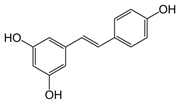 |
It possesses anti-amyloidogenic effect and inhibit the growth and synthesis of neurotoxic A fibrils. By helping to facilitate extracellular A's proteolytic clearance in neuronal cells and activating AMP-activated protein kinase, resveratrol reduced extracellular Aβ production in the cerebral cortex of transgenic mice. |
| 2. | Lycopene |  |
In a study by Alzobaidi, et al, high-fat diet-induced cognitive impairment in rats was found to be prevented by long-term lycopene ingestion, which also decreased infarct volume and neuronal death. In a rat model of bilateral carotid artery blockage-induced vascular dementia, Zhu et al. studied the preventative effect of lycopene on memory deterioration. According to the findings, chronic lycopene treatment effectively lowered oxidative stress and neuron-restrictive silencer factor (NRSF) release in the rats' brains. |
| 3. | Berberine | 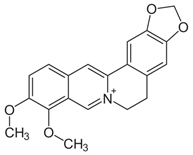 |
Alzobaidi, et al., investigated the hypothesis that altering the Amyloid Precursor Protein (APP) pathway in human neuroglioma H4 cells could lower amyloid levels to 30%. Another in vitro experiment by Zhao, et al., explored berberine's possible impact on Aβ-induced mitochondrial dysfunction in basic cultured hippocampus neurons. Berberine may help regulate mitochondrial membrane potential, improve mitochondrial motility and prevent synaptic loss, according to the results of the study. |
| 4. | Curcumin |  |
The results of the investigation showed that curcumin substantially improved memory impairments, attenuated oxidative damage and increased cholinergic activity in (STZ)-treated rats compared to controls. According to data from preclinical and clinical studies, curcumin has a crucial function in reducing neuro inflammatory cytokines such monocyte chemoattractant protein 1 (MCP-1), TNF-1, IL-6 and TGF-1. To assess the neuroprotective mechanisms of curcumin against A-induced neurotoxicity, Park, et al., carried out a cell line experiment in PC12 cells. The results showed that curcumin inhibited hyper phosphorylation of tau proteins linked with microtubules, lowered oxidative stress and decreased intracellular calcium influx. In Alzheimer's and dementia patients, curcumin has been demonstrated to improve glutathione levels, antioxidant enzyme activity and heme oxygenase activity. |
| 5. | Withfarin A | 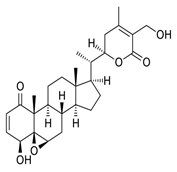 |
Withfarin A has demonstrated a neuroprotective impact in clinical and preclinical investigations, according to research by Alzobaidi, et al., in an experimental model of acute stress, these phytochemicals' potential for immunomodulation and antioxidant activity has been investigated. As a point of comparison, Withfarin A has been used because it inhibits the production of Amyloid (A), suppresses the NF-B pathway, lowers neuronal mortality, modifies synaptic transmission and restores antioxidant enzymes. |
| 6. | Thymoquinone | 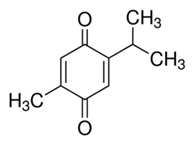 |
To determine the neuroprotective impact of thymoquinone (3 mg/kg body weight) against streptozotocin-induced cognitive impairment, Khan et al. studied rats for 15 days. The Morris Water Maze (MWM) study demonstrates that thymoquinone dramatically decreased the latency time and path length as well as the levels of oxidative stress indicators. Thymoquinone (1.642 mg) inhibited A1-42-induced neurotoxicity and stopped the depolarization of the mitochondrial membrane potential in cultured neurons from the hippocampus and cortical regions of rats. |
| 7. | Caffeine | 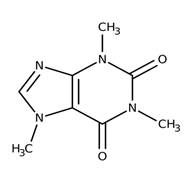 |
Many random controlled studies have proven that caffeine may have beneficial effects on cognition, according to Alzobaidi, et al., and Eskelinen, et al., When compared to low coffee users (0-2 cups), moderate coffee use (3-5 cups) was found to considerably lower the risk of dementia (65-70%) and Alzheimer's disease (62-64%) later in life (875 women and 534 men, age 50). Caffeine has been found by Arendash, et al., to have neuroprotective qualities in various in vitro and in vivo investigations because it shields cortical neurons from Aβ toxicity and prevents Aβ from impairing mice's memory. |
Table 1: Phytochemicals having neurodegeneration properties against dementia.
They were assessed using in silico docking analysis to investigate potential lead drugs for dementia. Using the molecular docking tools SWISS, seven phytochemicals have been investigated against putative inhibitors of Choline Esterase (ChE), N-Methyl-D-Aspartate (NMDA) and calcium channel receptors (target site). All 7 target-ligand complexes' energy values and ligands' profiles of Absorption, Distribution, Metabolism, Excretion and Toxicity (ADMET) were compared and examined. A number of potential obstacles to reaching drug status have failed as a result of in vitro ADME property studies being frequently conducted near the conclusion of the phase of drug development [12-16].
In silico ADME analysis lowers drug research expenditures while simultaneously lowering the possibility of a molecule being rejected. Additionally, one crucial aspect of pharmaceutical research involves visualizing target ligand complexes created following docking, which can reveal degrees of ligand binding fitness using estimated energy level. Therefore, the primary goal of this literature is to use in-silico ligand target prediction to forecast possible inhibitors against dementia [17-22].
Materials and Methods
Preparation of model building for docking
The Protein Data Bank (PDB) ids: 6QAE, 5KDT and 1T0J (Table 2) were used to retrieve the Three-Dimensional (3D) structures of Choline Esterase (ChE), N-Methyl-D-Aspartate (NMDA) and calcium channel receptors, respectively, with resolutions of 2.49, 2.44 and 2.00 A°. After carefully examining the available literature, the phytochemicals for the study were chosen. All of the phytochemicals used in this study were found to be helpful against dementia after being tested in vitro for several studies. Their structural information was acquired from the public zinc database.
Determination of binding site
A literature review was used to assess the protein's structure binding proteins and active sites. Protein binding sites are often seen in structural gaps and cavities that have a high affinity for selective drugs. Knowledge based studies have found the Choline Esterase (ChE), N-Methyl-D-Aspartate (NMDA) and calcium channel binding site. The results were calculated in terms of energy (e-value) per mol (Kcal/mol) in Table 4. The higher evalue, the more acceptable the chemical as a medicine. Protein structures were browsed via the internet software Swissdock. It automatically searches the structure from the zinc database based on the chemical name, displays the results and docks the picked molecule in various places of the target protein. The results were sent to an email address that we provide. The results can be viewed at the UCSF website or at the link supplied in the email. Chimera can be launched with a single click and its view dock plugin immediately loads the expected binding modes [23-30].
Drug-likeness and ADME analysis
Implementing the Molinspiration server for the calculation of their molecular properties, an in-silico drug likeness of phytochemicals assessment was carried out to determine whether potential ligands could adhere to Lipinski's rule of five (Table 3). Using the Swiss-ADME web server, likely phytochemicals' in-silico ADME (Absorption, Distribution, Metabolism and Excretion) properties were predicted (Table 2).
| Targets-PDB Id | 3D Structure |
|---|---|
| Choline esterase-6QAE | 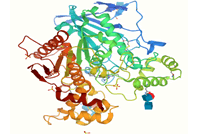 |
| N-Methyl-D-Aspartate (NMDA)-5KDT | 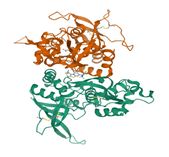 |
| Calcium channel-1T0J | 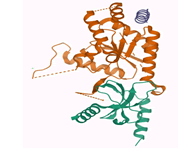 |
Table 2: 3D structure of potential inhibitors (targets) against dementia.
Results and Discussion
To determine the optimal agonists that can slow the neurodegeneration of dementia, phytochemicals have been docked in silico with the receptors for Choline Esterase (ChE), N-Methyl-D-Aspartate (NMDA) and calcium channels. With the exception of lycopene, all other potential compounds adhered to Lipinski's rule of five without deviating in terms of octanol-water partition coefficient (LogP 5), molecular weight (500 KDa), number of H-bond donors, number of H-bond acceptors and molecular refractivity, as shown in Table 3. As a result, logP was observed for resveratrol, curcumin and thymoquinone, showing substantial CNS penetration and lipophilicity. [31-36].
As part of the ADMET assessment, various pharmacokinetic factors have been taken into consideration, including GI absorption, blood-brain barrier penetration, Cytochrome P (CYP) inhibitory effects and skin permeability. Table 4 provides an overview of the findings. Resveratrol, curcumin and thymoquinone also possessed logP (1-3) as a result, demonstrating potent CNS penetration and lipophilicity.
Different pharmacokinetic factors, including GI absorption, blood-brain barrier penetration, Cytochrome P (CYP) inhibitory effects and skin permeability, were taken into account when evaluating ADMET. Table 4 presents a summary of the findings. As a result, compared to other phytochemicals, resveratrol, berberine and thymoquinone showed BBB penetration.
Our investigations revealed that Swiss DOCK tools had been involved in the binding energy between the ligand and the target molecule. The binding energies for resveratrol, lycopene, berberine, curcumin, withaferin A, thymoquinone and caffeine against the NMDA receptor, the calcium channel receptor and the Choline Esterase (ChE) receptor were calculated using Swiss DOCK tools and they were in the range of -6.39 to -8.91 kcal/mol, -5.82 to -7.54 kcal/mol, respectively [37].
In Table 5, the energy value has been reported. The phytochemicals docked in this tool showed a varied arrangement of binding energies. When docked in swiss dock, where a mixed ability of saponins, lignins, phenols and alkaloids was seen to rank highly, flavonoids were observed to rank higher. The results suggested that seven chemical substances had higher binding energy values for the Choline Esterase (ChE) receptor (Tables 3-5) [38-41].
| Ligands | Resveratrol | Lycopene | Berberine | Curcumin | Withaferin A | Thymoquinone | Caffeine |
|---|---|---|---|---|---|---|---|
| MW (g/mol) | 228.25 | 536.89 | 336.37 | 368.38 | 470.61 | 164.2 | 194.19 |
| LogP | 2.9 | 9.98 | 0.2 | 2.3 | 3.86 | 1.9 | 0.06 |
| TPSA | 60.68 | 0 | 40.82 | 93.07 | 96.36 | 34.14 | 61.84 |
| n ON | 3 | 0 | 5 | 6 | 6 | 2 | 6 |
| n OHNH | 3 | 0 | 0 | 2 | 2 | 0 | 0 |
| n rotb | 2 | 16 | 2 | 8 | 3 | 1 | 0 |
| n atoms | 17 | 40 | 25 | 27 | 34 | 12 | 14 |
| n violations | 0 | 2 | 0 | 0 | 0 | 0 | 0 |
Table 3: Lipinski's rule of five drugs like characteristics of prospective substances using the Molinspiration web-server. Note: n ON, number of hydrogen bond acceptor; n OHNH, number of hydrogen bond donor; MW: Molecular Weight; LogP, lipophilic efficiency; TPSA stands for topological polar surface area, n violations for Lipinski's rule of five, n rotb for rotatable bonds and n atoms for the total number of atoms.
| ADME | Resveratrol | Lycopene | Berberine | Curcumin | Withaferin A | Thymoquinone | Caffeine |
|---|---|---|---|---|---|---|---|
| GI absorption | High | Low | High | High | High | High | High |
| BBB permeation | Yes | No | Yes | No | No | Yes | No |
| P-gp substrate | No | Yes | Yes | No | Yes | No | No |
| CYP1A2 inhibitor | Yes | No | Yes | No | No | No | No |
| CYP2C19 inhibitor | No | No | No | No | No | No | No |
| CYP2C9 inhibitor | Yes | No | No | Yes | No | No | No |
| CYP2D6 inhibitor | No | No | Yes | No | No | No | No |
| CYP3A4 inhibitor | Yes | No | Yes | Yes | No | No | No |
| Log Kp (skin permeation) cm/s | -5.47 | 1.47 | -5.78 | -6.28 | -6.45 | -5.74 | -7.53 |
Table 4: ADME the characteristics of potential compounds predicted from SwissADME web-server. Note: BBB, blood-brain barrier penetration; GI, gastric intestine absorption; Absorption, Distribution, Metabolism and Excretion (ADME); cytochrome P or CYP I can confirm that, No, not verified; a high rate of absorption; low-absorption levels.
| Ligand-zinc id | Estimated binding free energies (∆G) | ||
|---|---|---|---|
| Choline esterase receptors | N-Methyl-D-Aspartate (NMDA) receptors | Calcium channel receptors | |
| Resveratrol | -7.22 | -7.23 | -6.99 |
| Lycopene | -8.49 | -8.74 | -5.82 |
| Berberine | -8.35 | -6.97 | -7.17 |
| Curcumin | -7.32 | -8.29 | -7.38 |
| Withaferin A | -8.91 | -8.86 | -7.54 |
| Thymoquinone | -6.39 | -6.38 | -5.93 |
| Caffeine | -6.58 | -7.00 | -6.36 |
Table 5: In the active sites of choline esterase (ChE), N-Methyl-D-Aspartate (NMDA) and calcium channel receptors, swiss dock calculated the free energies of binding (G) of phytochemicals.
Conclusion
In the current job, resulting in seven phytochemicals have been selected from a literature review and docked using swiss dock against the NMDA, calcium channel and Choline Esterase (ChE) receptors to reveal promising lead compounds for treating dementia. The compounds were also assessing for their ADME properties. Additionally, resveratrol, lycopene, berberine, curcumin, withaferin A, thymoquinone and caffeine have been identified as prospective phytochemicals that need to be examined for utilization as strong medicines against dementia. The Choline Esterase (ChE) receptor has a high binding affinity for these substances. In addition, berberine and resveratrol showed positive ADME characteristics and can be regarded as safe for progress into pharmaceutical uses. The outcome of the results certainly shed insight on the possibility of using resveratrol and berberine as a model for developing new drugs to treat dementia.
Declaration of Interest
Author declares no conflict of interests.
Acknowledgements
Authors acknowledge Shri Rawatpura Sarkar institute of pharmaceutial sciences. Kumhari, Durg Chhattisgarh and Rungta institute of pharmaceutical sciences, Bhilai, Chhattisgarh and Rungta college of pharmaceutical sciences, Nandanvan, Raipur, Chhattisgarh for providing database search facility.
Funding Sources
No source of funding.
References
- Alzobaidi N, Quasimi H, Emad NA, et al. Degener Neurol Neuromuscul Dis. 2021; 12 (4): p. 1-4.
[Crossref] [Google Scholar] [PubMed]
- Rossor MN, Fox NC, Mummery CJ, et al. Lancet Neurol. 2010; 9(8): p. 793-806.
[Crossref] [Google Scholar] [PubMed]
- Tripathi M, Vibha D. Indian J Psychiatry. 2009; 19(5): 51-53.
[Google Scholar] [PubMed]
- Iadecola C. Neuron. 2013; 80(4): p. 844-866.
[Crossref] [Google Scholar] [PubMed]
- Rivas-Arancibia S, Hernández-Zimbrón LF, Rodríguez-Martínez E, et al. Adv Biosci Biotechnol. 2013; 4(11): p. 24-28.
- Yan D, Zhang Y, Liu L, Yan H. Sci Rep. 2016; 6(1): p. 322-342.
[Crossref] [Google Scholar] [PubMed]
- Mecocci P, Tinarelli C, Schulz RJ, Polidori MC. Front pharmacol. 2014; 5 (1):147-150.
[Crossref] [Google Scholar] [PubMed]
- Van Marum RJ. Neuropsychiatr Dis Treat. 2009; 5: p. 237-247.
[Crossref] [Google Scholar] [PubMed]
- Mirza MU, Mirza AH, Ghori NU, et al. Drug Des Devel Ther. 2014: 17(7): p. 187-198.
[Crossref] [Google Scholar] [PubMed]
- Sudha K, Rao AV, Rao S, Rao A. Neurol India. 2003; 51(1): 60-62.
[Google Scholar] [PubMed]
- Roghani M, Behzadi G. Brain Res. 2001; 892(1): p. 211-217.
[Crossref] [Google Scholar] [PubMed]
- Nicoletti G, Crescibene L, Scornaienchi M, et al. Arch Gerontol Geriatr. 2001; 33(1): p. 7-12.
[Crossref] [Google Scholar] [PubMed]
- Etminan M, Gill SS, Samii A. Lancet Neurol. 2005; 4(6): p. 362-365.
[Crossref] [Google Scholar] [PubMed]
- Paraskevas GP, Kapaki E, Petropoulou O, et al. J Neurol Sci. 2003; 215(1-2): p. 51-55.
- Feng Y, Wang XP, Yang SG, et al. Neurotoxicol. 2009; 30(6): p. 986-995.
- Vingtdeux V, Giliberto L, Zhao H, et al. J Biol Chem. 2010; 285(12): p. 9100-9113.
[Crossref] [Google Scholar] [PubMed]
- Lei X, Lei L, Zhang Z, et al. Mol Med Rep. 2016; 13(1): p. 412-418.
- Zhu NW, Yin XL, Lin R, et al. Neural Regen Res. 2020; 15(2): p. 332.
[Crossref] [Google Scholar] [PubMed]
- Asai M, Iwata N, Yoshikawa A, et al. Biochem Biophys Res Commun. 2007; 352(2): p. 498-502.
[Crossref] [Google Scholar] [PubMed]
- Zhao C, Su P, Lv C, et al. Oxid Med Cell Longev. 2019; 34(27): p. 566-576.
[Crossref] [Google Scholar] [PubMed]
- Panahi Y, Hosseini MS, Khalili N, et al. Biomed Pharmacother. 2016; 82 (9): p. 578-582.
[Crossref] [Google Scholar] [PubMed]
- Park SY, Kim HS, Cho EK, et al. Food Chem Toxicol. 2008; 46(8): p. 2881-2887.
[Crossref] [Google Scholar] [PubMed]
- Molino S, Dossena M, Buonocore D, et al. Life Sci. 2016; 161(87): p. 69-77.
[Crossref] [Google Scholar] [PubMed]
- Agrawal R, Mishra B, Tyagi E, et al. Pharmacol Res. 2010; 61(3): p. 247-252.
[Crossref] [Google Scholar] [PubMed]
- Ganguli M, Chandra V, Kamboh MI, et al. Arch Neurol. 2000; 57(6): p. 824-830.
[Crossref] [Google Scholar] [PubMed]
- Farooqui AA, Farooqui T, Madan A, et al. Evid Based Complementary Altern Med. 2018; 18(7): p. 23-26.
[Crossref] [Google Scholar] [PubMed]
- Khan A, Khuwaja G, Khan MB. Ann Neurosci. 2008; 15: p. 91-94.
- Alhebshi AH, Gotoh M, Suzuki I. Biochem Biophys Res Commun. 2013; 433(4): p. 362-367.
[Crossref] [Google Scholar] [PubMed]
- Arendash GW, Schleif W, Rezai-Zadeh K, et al. Neuroscience. 2006; 142(4): 941-952.
[Crossref] [Google Scholar] [PubMed]
- Eskelinen MH, Ngandu T, Tuomilehto J, et al. J Alzheimer's Dis. 2009; 16(1): p. 85-91.
[Crossref] [Google Scholar] [PubMed]
- Pathak A, Madar IH, Raithatha K, et al. MOJ Proteomics Bioinform.2017; 1 (4): p. 45-47.
- Mirza MU, Mirza AH, Ghori NU, et al. Drug Des Devel Ther. 2014: 98(67): p. 187-198.
[Crossref] [Google Scholar] [PubMed]
- Daina A, Michielin O, Zoete V. Scientific Rep. 2017; 7(1):p. 427-517.
[Crossref] [Google Scholar] [PubMed]
- Li Q, Cheng T, Wang Y, et al. Drug Discov Toda. 2010; 15(23-24): p. 1052-1057.
[Crossref] [Google Scholar] [PubMed]
- Lipinski CA. Drug Discov Toda. 2004; 1(4): p.337-341.
[Crossref] [Google Scholar] [PubMed]
- Wang X, Shen Y, Wang S, et al. Nucleic Acids Res. 2017; 45(23): p. 56-60.
[Crossref] [Google Scholar] [PubMed]
- Wang Z, Liang L, Yin Z, et al. J Cheminformatics. 2016; 8 (4): p. 1-0.
[Crossref] [Google Scholar] [PubMed]
- Wolber G, Dornhofer AA, Langer T. J Comput Aided Mol Des. 2006; 20(12): p. 773-788.
[Crossref] [Google Scholar] [PubMed]
- Orchard S, Al-Lazikani B, Bryant S, et al. Nat Rev Drug Discov. 2011; 10(9): p. 661-669.
[Crossref] [Google Scholar] [PubMed]
- Nickel J, Gohlke BO, Erehman J, et al. Nucleic Acids Res. 2014; 7(5): p. 78-80.
[Crossref] [Google Scholar] [PubMed]
- Huang HJ, Yu HW, Chen CY, et al. J Taiwan Inst Chem Eng. 2010; 41(6): p. 623-635.



